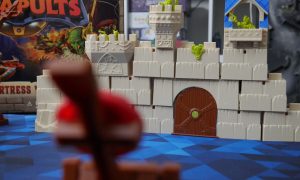 Lara Croft huddles inside a large crevice running through the side of a cliff face, shivering from the cold. She warms herself near a fire, having just survived a shipwreck, a kidnapping, being impaled by a rusty spike, a cave-in, and almost being flattened by a Japanese World War II-era fighter plane.
Lara Croft huddles inside a large crevice running through the side of a cliff face, shivering from the cold. She warms herself near a fire, having just survived a shipwreck, a kidnapping, being impaled by a rusty spike, a cave-in, and almost being flattened by a Japanese World War II-era fighter plane.
She questions her resolve. She’s frightened. Alone.
Then, her radio crackles to life. Her friends are on the other end. She’s given new hope, and convinces herself to continue.
Little does she know that this is only the beginning of her arduous journey.
Tomb Raider is about new beginnings – not only of Lara’s beginning as an adventurer, but of Crystal Dynamics creating a new beginning for the long-storied franchise. Here, we see Lara Croft as a fresh-faced teenager, eager to explore untold legends and uncharted depths. But there’s also a naivete behind that face, one that is clearly unprepared for the trials that lay ahead. On the flip side, we have Crystal Dynamics, an extremely capable team that has taken years of distilling what makes Lara who she is, and figuring out how they can transform her into a hero for the 21st century.
[singlepic id=11021 w=320 h=240 float=left]In doing so, they’ve taken Tomb Raider from a wacky, cartwheeling romp against dinosaurs to a gritty survival tale, where one woman stands against a crazed cult, a demonic horde, and the harsh elements of Yamatai Island – much more Temple of Doom than Raiders of the Lost Ark in terms of tone. In fact, there are very few tombs to be raided within Tomb Raider, and what few there are are relegated to brief, optional puzzle challenges.
Instead, we have a story focusing on a mysterious and powerful supernatural force that governs the Bermuda Triangle-like qualities of Yamatai Island. Those who find themselves wandering near it end up stuck on its shores, as freak storms batter and destroy any craft that makes the unfortunate choice of trying to find the place. There’s a mysterious beauty behind the island, with lush, vibrant jungles, snow-capped mountain tops, and gushing river rapids. Underneath this beauty lies a much darker side – derelict grave sites, a decrepit shantytown — and yes, even tombs — all lurk underneath the surface, and there’s more to this island than meets the eye.
It feels a lot like the television show Lost – just when you think you’re beginning to understand the island and the situation surrounding it, some new wrinkle introduces itself. Finding all of the hidden documents that are strewn about opens up the mystery even further, as you read about the trials of the various unfortunate souls that have ended up trapped on the island before you. Lara is thrown into this mix, starting as an ambitious, thrill-seeking assistant to a documentary crew, and is quickly forced to thrive off the land, skirt danger, and most importantly – how to kill.
[singlepic id=11022 w=320 h=240 float=right]The way Tomb Raider deals with this transformation was one of the selling points of the game, and unfortunately, it’s one of the weakest. The tension during the moment when Lara is about to claim a human life for the first time is nail-biting, and it’s handled with rather brilliant emotional impact – only to be washed away within the next few moments as she immediately becomes an unstoppable video game character badass. It’s unfortunate that this scene, which should carry an enormous weight – both on Lara as well as the player – is shoved aside shortly after it happens. It may be the nature of the medium of video games, but it could have been handled better – or, at the very least, differently.
Despite this rather jarring shift, Lara quickly becomes an incredibly competent survivor, and she uses every tool at her disposal in an effort to escape the island. All she’ll have at the outset is a torch and a bow, but those won’t be enough in uncovering all of the secrets lying around the island. Each area is rather large, with one or two traversal methods available at the outset, all funneling Lara towards her next objective. As she jumps, climbs, and shimmies her way onward, she’ll quickly stumble across insurmountable cliff walls, or incredible chasms, leaving her at an impasse – at least until she finds the right equipment.
She’ll always be able to find the right sets of tools to continue her constant march towards the game’s finale, though there will always be a section or two in each environment that won’t open until she returns with some vital gadget that will unlock a nicely hidden bauble, document, or other trinket, each find rewarding a fat set of salvage or XP. This sequence of find/return/unlock isn’t as pronounced as in games like Metroid, as Lara is almost constantly moving forward, but occasionally she’ll find herself doubling back on previously discovered locations, able to use newly found toys to uncover further hidden secrets and tombs. Even in such a dangerous world, there is a constant thrill of discovery – there’s always something new to find on Yamatai Island.
[singlepic id=11023 w=320 h=240 float=left]Searching every nook and cranny has its benefits, as Lara will need every piece of salvage and XP that she can muster. Finding items like relics or documents provide smaller XP boosts, while puzzling through the optional tombs or completing sets of challenges and collecting every item in a set provide larger bonuses. Salvage is earned through hunting, or opening various boxes strewn about the island. Once Lara finds herself at a campsite, she can use these newly acquired goods in order to upgrade her abilities or weapons. Backtracking is also possible, as many campsites have a fast travel option to zip around the island, though going back for the odd treasure is never really necessary – as long as Lara is diligent in exploring her current surroundings, she’ll usually have enough power to survive any encounter.
Lara’s combat prowess arrives just as quickly as her love for bloodshed, and each encounter can play out in several different ways. If she gets the drop on the cultists, she can sneak around, picking off foes one by one with either the bow, or with a silent takedown. If things get hairy, she’s more than capable in laying waste to everything that moves. Taking cover and taking out bad guys is incredibly fluid and natural, and the entire combat flow feels like the best combination between Resident Evil 4 and Batman: Arkham Asylum.
All of these seemingly disparate elements – exploration, combat, player progression – combine to form one of the most perfectly paced games of this generation. There’s literally never a good moment to walk away from Tomb Raider, as there’s always some reward lurking just around the corner – be it a new weapon or tool, a hidden secret, even just a new location. There’s always a constant drive toward the finish line, and there’s always a reason to keep hands glued to the controller. Just when running around and exploring starts to get tiresome, the game throws in some enemies to fight; when combat begins to wear out its welcome, in comes a puzzle to save the day. Combat is always used to punctuate Tomb Raider’s many elegant set pieces, and never as filler.
[singlepic id=11024 w=320 h=240 float=right]In fact, the only time Tomb Raider falters is when it throws too much at Lara. She gets jostled around like a rag doll in a spin cycle, and there are moments where the game gets too loud, the violence a bit too gratuitous. Clearly Crystal Dynamics is trying to accomplish the same thing that the recent James Bond films have done with their own character – they reinvented the franchise, broke the hero, sent them to the lowest point they could, then reestablished them as a true survivor. While the developers should be applauded for what they’ve done – as this reinvention mostly works – sometimes they push a little too far.
One scene in particular has Lara trying to cross a rushing river, getting whisked away, dodging incredibly jagged rocks and poles (complete with an incredibly unnerving death sequence should Lara hit one), only to fall off the river and into a derelict fighter plane. Cockpit window shatters. Parachute fails. And so on. Luckily, most of these sequences occur during the first few hours, finally letting the environments breathe a bit, and the game quickly finds its stride.
Other than a few missteps here and there, and a completely forgettable multiplayer mode (think Uncharted, but worse), Tomb Raider is the quintessential example of a reboot done right. Crystal Dynamics has granted Lara Croft new life – and more importantly, purpose – and for the first time in over a decade, further adventures in the Tomb Raider saga will be met with anticipation and excitement, rather than groans and eye-rolls. Tomb Raider represents a new beginning – not only for Lara, but for cinematic games as a whole. Consider the bar officially raised.
I've been gaming since my dad made the bad decision of buying me a Nintendo when I was four years old. Every day I'd find myself with my face glued to a TV screen, punching away at buttons, getting furious with Bowser, Dr. Wily, and those freakin' birds in Ninja Gaiden. Since then I have failed to get my parents to play any board game with me, I sold my full copy of Earthbound with box and guide for $300 to some dude in Austria for rent money, and I still believe in Nintendo even after all these years.

See below for our list of partners and affiliates:























